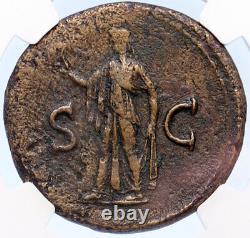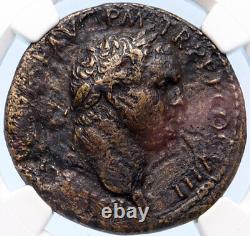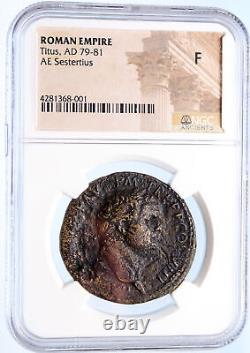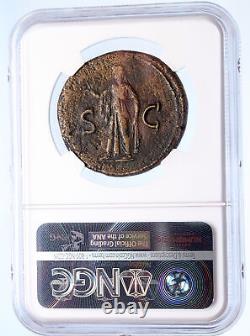
- Homepage
- Certification
- Composition
- Date
- Denomination
- Ae Prutah (34)
- Ae3 (14)
- Antoninianus (102)
- Ar Denarius (40)
- Aurelianianus (12)
- Aureus (145)
- Bi Double Denarius (24)
- Bi Nummus (22)
- Centenionalis (16)
- Cistophorus (24)
- Denarius (1265)
- Double Denarius (63)
- Dupondius (16)
- Nummus (119)
- Prutah (27)
- Quadrigatus (13)
- Sestertius (126)
- Siliqua (15)
- Solidus (169)
- Tetradrachm (21)
- Other (602)
- Ruler
- Antoninus Pius (52)
- Augustus (141)
- Caracalla (51)
- Constantine I (57)
- Constantine Ii (29)
- Domitian (58)
- Gallienus (37)
- Gordian Iii (62)
- Hadrian (100)
- Marcus Aurelius (67)
- Nero (113)
- Nerva (31)
- Philip I (66)
- Septimius Severus (35)
- Severus Alexander (69)
- Theodosius Ii (32)
- Tiberius (69)
- Trajan (97)
- Trajan Decius (28)
- Vespasian (76)
- Other (1599)
- Year
TITUS Genuine 80AD Rome Sestertius Spes Authentic Ancient Roman Coin NGC i66862






Item: i66862 Authentic Ancient Coin of. Bronze Sestertius 33mm (24.37 grams) Rome mint, struck 80-81 A.
Reference: RIC 168 Certification: NGC Ancients. F 4281368-001 IMP T CAES VESP AVG P M TR P P P COS VIII, laureate head right. Spes standing left, holding flower and raising hem of skirt; S-C across fields. Titus Flavius Vespasianus, commonly known as Titus (December 30, 39 - September 13, 81), was a Roman Emperor who briefly reigned from 79 until his death in 81.
Titus was the second emperor of the Flavian dynasty, which ruled the Roman Empire between 69 and 96, encompassing the reigns of Titus's father Vespasian (69-79), Titus himself (79-81) and his younger brother Domitian (81-96). Prior to becoming emperor, Titus gained renown as a military commander, serving under his father in Judaea during the First Jewish-Roman War, which was fought between 67 and 70. When Vespasian was declared emperor on July 1, 69, Titus was left in charge of ending the Jewish rebellion, which he did in 70, successfully besieging and destroying the city and the Temple of Jerusalem. For this achievement Titus was awarded a triumph; the Arch of Titus commemorates his victory to this day. Under the rule of his father, Titus gained infamy in Rome serving as prefect of the Roman imperial bodyguard, known as the Praetorian Guard, and for carrying on a controversial relationship with the Jewish queen Berenice. Despite concerns over his character, however, Titus ruled to great acclaim following the death of Vespasian on June 23, 79, and was considered a good emperor by Suetonius and other contemporary historians. In this role he is best known for his public building program in Rome-completing the Flavian Amphitheatre, otherwise known as the Colosseum- and for his generosity in relieving the suffering caused by two disasters, the Mount Vesuvius eruption of 79 and the fire of Rome of 80.After barely two years in office, Titus died of a fever on September 13, 81. He was deified by the Roman Senate and succeeded by his younger brother Domitian. In 66 the Jews of the Judaea Province revolted against the Roman Empire.
Cestius Gallus, the legate of Syria, was defeated at the battle of Beth-Horon and forced to retreat from Jerusalem. The pro-Roman king Agrippa II and his sister Berenice fled the city to Galilee where they later gave themselves up to the Romans.
Nero appointed Vespasian to put down the rebellion, who was dispatched to the region at once with the fifth and tenth legions. He was later joined by Titus at Ptolemais, bringing with him the fifteenth legion.
With a strength of 60,000 professional soldiers, the Romans prepared to sweep across Galilee and march on Jerusalem. The history of the war was covered in dramatic detail by the Roman-Jewish historian Josephus in his work The Wars of the Jews.Josephus served as a commander in the city of Jotapata when the Roman army invaded Galilee in 67. After an exhausting siege which lasted 47 days, the city fell, with an estimated 40,000 killed and the remaining Jewish resistance committing suicide. Josephus himself surrendered to Vespasian, became a prisoner and provided the Romans with intelligence on the ongoing revolt. By 68, the entire coast and the north of Judaea were subjugated by the Roman army, with decisive victories won at Taricheae and Gamala, where Titus distinguished himself as a skilled general. Meanwhile the Jews had become embroiled in a civil conflict of their own, splitting the resistance in the city among two factions; the Sicarii led by Simon Bar Giora, and the Zealots led by John of Gischala.
Titus seized the opportunity to begin the assault on Jerusalem. The Roman army was joined by the twelfth legion, which was previously defeated under Cestius Gallus, and from Alexandria Vespasian sent Tiberius Julius Alexander, governor of Ægyptus, to act as Titus's second in command. Titus surrounded the city, with three legions (Vth, XIIth and XVth) on the western side and one (Xth) on the Mount of Olives to the east.He put pressure on the food and water supplies of the inhabitants by allowing pilgrims to enter the city to celebrate Passover, and then refusing them egress. Jewish raids continuously harassed the Roman army, one of which nearly resulted in Titus being captured. After attempts by Josephus to negotiate a surrender had failed, the Romans resumed hostilities and quickly breached the first and second walls of the city. To intimidate the resistance, Titus ordered deserters from the Jewish side to be crucified around the city wall.
By this time the Jews had been thoroughly exhausted by famine, and when the weak third wall was breached bitter street fighting ensued. The Romans finally captured the Antonia Fortress and began a frontal assault on the gates of the Temple. According to Josephus, Titus had ordered that the Temple itself should not be destroyed, but while the fighting around the gates continued a soldier hurled a torch inside one of the windows, which quickly set the entire building ablaze. The later Christian chronicler Sulpicius Severus, possibly drawing on a lost portion of Tacitus' Histories, claims that Titus favoured destruction of the Temple. Whatever the case, the Temple was completely demolished, after which Titus's soldiers proclaimed him imperator in honor of the victory.Jerusalem was sacked and much of the population killed or dispersed. Josephus claims that 1,100,000 people were killed during the siege, of which a majority were Jewish. 97,000 were captured and enslaved, including Simon Bar Giora and John of Gischala.
Many fled to areas around the Mediterranean. Titus reportedly refused to accept a wreath of victory, as he claimed there is "no merit in vanquishing people forsaken by their own God". Titus' triumph after the First Jewish-Roman War was celebrated with the Arch of Titus in Rome, which shows the treasures taken from the Temple in Jerusalem, including the Menorah and the Trumpets of jericho.
Unable to sail to Italy during the winter, Titus celebrated elaborate games at Caesarea Maritima and Berytus, then travelled to Zeugma on the Euphrates, where he was presented with a crown by Vologases I of Parthia. While visiting Antioch he confirmed the traditional rights of the Jews in that city.
On his way to Alexandria, he stopped in Memphis to consecrate the sacred bull Apis. According to Suetonius, this caused consternation; the ceremony required Titus to wear a diadem, which the Romans associated with kingship, and the partisanship of Titus's legions had already led to fears that he might rebel against his father. Upon his arrival in the city in 71, Titus was awarded a triumph.Accompanied by Vespasian and Domitian he rode into the city, enthusiastically saluted by the Roman populace and preceded by a lavish parade containing treasures and captives from the war. Josephus describes a procession with large amounts of gold and silver carried along the route, followed by elaborate re-enactments of the war, Jewish prisoners, and finally the treasures taken from the Temple of Jerusalem, including the Menorah and the Pentateuch.
Simon Bar Giora was executed in the Forum, after which the procession closed with religious sacrifices at the Temple of Jupiter. The triumphal Arch of Titus, which stands at one entrance to the Forum, memorializes the victory of Titus. World-renowned expert numismatist, enthusiast, author and dealer in authentic ancient Greek, ancient Roman, ancient Byzantine, world coins & more.Ilya Zlobin is an independent individual who has a passion for coin collecting, research and understanding the importance of the historical context and significance all coins and objects represent. Send me a message about this and I can update your invoice should you want this method. Getting your order to you, quickly and securely is a top priority and is taken seriously here. Great care is taken in packaging and mailing every item securely and quickly. What is a certificate of authenticity and what guarantees do you give that the item is authentic?
You will be very happy with what you get with the COA; a professional presentation of the coin, with all of the relevant information and a picture of the coin you saw in the listing. Additionally, the coin is inside it's own protective coin flip (holder), with a 2x2 inch description of the coin matching the individual number on the COA. Whether your goal is to collect or give the item as a gift, coins presented like this could be more prized and valued higher than items that were not given such care and attention to.
When should I leave feedback? Please don't leave any negative feedbacks, as it happens sometimes that people rush to leave feedback before letting sufficient time for their order to arrive.The matter of fact is that any issues can be resolved, as reputation is most important to me. My goal is to provide superior products and quality of service. How and where do I learn more about collecting ancient coins? Visit the Guide on How to Use My Store. For on an overview about using my store, with additional information and links to all other parts of my store which may include educational information on topics you are looking for.
This item is in the category "Coins & Paper Money\Coins: Ancient\Roman: Imperial (27 BC-476 AD)". The seller is "highrating_lowprice" and is located in this country: US. This item can be shipped worldwide.
- Certification Number: 4281368-001
- Certification: NGC
- Grade: F
- Year: 80-81 AD
- Ruler: Titus
- Denomination: Sestertius
- Era: Ancient

